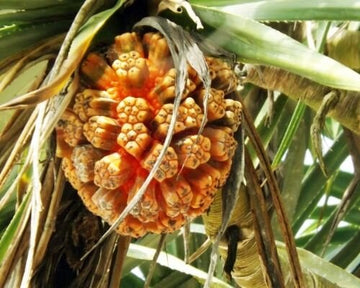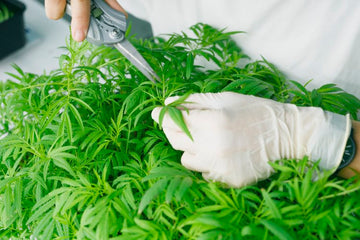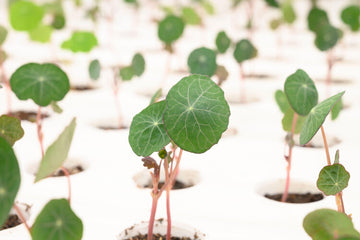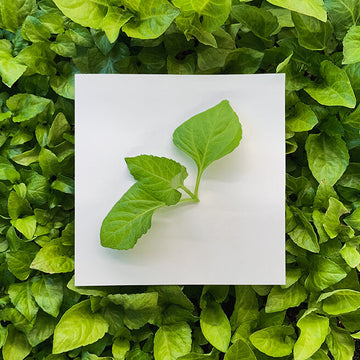
1. Pandanus, Screw Pine (Pandanus tectorius) 露兜樹

Pandanus Fruit. Orange indicates ripeness.

It often is found on the edges of beaches around Hong Kong.
Native: Yes
Flowering Period: May-Aug
Fruiting Period: Jan-Oct
You may have seen a large, spiky plant with protruding, tube-like roots anchoring them to the edges of beaches or rocky shorelines of Hong Kong, and sporting a green or orange pineapple-like fruit at the center of its prickly leaves. This was likely a variety of Pandanus, commonly known as Screw Pine, a fantastically useful plant that is an important source of food and and fiber material around the world.
There are six commonly found varieties of Pandanus in Hong Kong, and over 700 varieties globally. Naturally found in tropical and sub-tropical climates, they've been spread throughout the world as the fruit floats along ocean currents. Pandanus are extremely hardy, drought-resistant plants that can tolerate strong winds and salty ocean spray. This makes them perfectly adapted to life in Hong Kong, with its rocky coast and unpredictable typhoons.
Pandanus is useful as a food crop and textile source, particularly in the Pacific Polynesian Region, where it is commonly cultivated. There are several subgroups of pandanus, but the pandanus tectorius commonly seen in Hong Kong falls into the group commonly used for its edible fruit.
Consisting of an outer ball of long spiky seeds, it contains an edible pulpy center that can be eaten raw, cooked, or ground into a flour-like paste for thick flat cakes. The flour made from its fruit is also diluted with water and has palm sugar added to it to form a popular drink in Polynesia. The stiff, spiky leaves are shredded into fibers to weave baskets, mats, and other useful items.
The Screw Pine may be overlooked as a source of food and textiles in Hong Kong, where there it seems to bear little to no cultural significance. Next time you see a ripe spiky orange ball peeking from a pandanus tree, perhaps you can collect it and experiment in utilizing its varied potential!

While they are commonly found in tropical climates, they can apparently adapt very well to a variety of conditions. Here’s a huge pandanus tree I saw up in the Himalayan foothills of Sikkim, India,
2. Wood Sorrel, Oxalis (Oxalis corniculata L.) 酢漿草

Wood sorrel with yellow flowers.

In Hong Kong, the purple flowers may be more commonly seen than the yellow.
Native: Yes
Flowering Period: April-Sep, but pretty much throughout the year in Hong Kong
Wood sorrel is commonly seen as a weed in gardens all over the world, and Hong Kong is no exception. Even if you grow in containers on a balcony 20 floors up, you will not be surprised to see the unmistakable small clover like wood sorrel peeking out amongst your flowers and herbs. Once you begin to recognize this plant, you'll start seeing it everywhere - in cracks on the sidewalk while you wait for the bus, or sprouting from drains in concrete slopes.
In Hong Kong, the purple flower variety may be more widespread. You might be surprised to know that both the leaves and flowers are edible, and have a sharp lemony tartness. At Common Farms we grow red oxalis (oxalis triangularis) which is in the same family but more favored by chefs for its eye-catching triangular shaped magenta leaves.
As their name suggests, all oxalis plants contain oxalic acid, giving them their distinctive flavor. While it is fine to eat in small quantities (after all, it's present in kale and spinach as well) it shouldn't be eaten in large amounts or it can bind up calcium in the body, leading to nutritional deficiency. Oxalis leaves and flowers are an excellent complement to sweet dishes like cupcakes or tarts, where you want to balance out the sweetness with sour notes.

Red Oxalis (Oxalis Triangularis) grown at Common Farms - a chef favorite for plating!
For more information on the plants above, as well as suggested culinary and medicinal uses, please refer to the links below!
Disclaimer: The information contained in this article is for reference only. Consult your medical professional before using any of the plants mentioned to treat a medical condition.
Sources:
https://www.herbarium.gov.hk/subpages.aspx?id=6539
https://www.herbarium.gov.hk/subpages.aspx?id=3648
http://www.eattheweeds.com/pandanus/
http://tropical.theferns.info/viewtropical.php?id=Pandanus+tectorius
https://en.wikipedia.org/wiki/Oxalis_triangularis
https://pfaf.org/user/plant.aspx?LatinName=Oxalis+corniculata
http://www.eattheweeds.com/oxalis-how-to-drown-your-sorrels/




